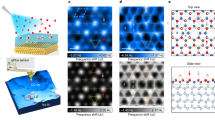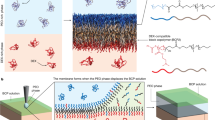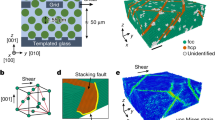Abstract
The nature of monolayer collapse has long interested physical chemists studying surface phenomena1–3, and is also of interest to biologists seeking cell-membrane models4, since monolayers of fatty-acid type molecules are often used as models for each half of the biomembrane bilayers, and double layers or bilayers may well form on monolayer collapse. Furthermore thin-film properties of fatty acids are similar in many ways to those of cholesterol, lecithins, and other important components of biomembranes. There is little direct experimental evidence to support proposed collapse mechanisms, however. In this note a remarkable type of monolayer collapse is described. Pressure–area isotherms for 2-hydroxytetracosanoic (cerebron) acid rise steeply and bend over sharply at a high pressure without the subsequent falloff in pressure expected for such rigid films. Electron micrographs of the collapsing film clearly show many folds or ridges of unusual stability. The compressed monolayer thus provides a model for membranes and thicker films under compression.
This is a preview of subscription content, access via your institution
Access options
Subscribe to this journal
Receive 51 print issues and online access
$199.00 per year
only $3.90 per issue
Buy this article
- Purchase on Springer Link
- Instant access to full article PDF
Prices may be subject to local taxes which are calculated during checkout
Similar content being viewed by others
References
Gaines, G. L. Jr Insoluble Monolayers at Liquid-Gas Interfaces, 144–151 (Interscience, New York, 1966).
Neuman, R. D. J. Coll. Interface Sci. 56, 505–510 (1976).
Ries, H. E. Jr. & Kimball, W.A. J. phys. Chem. 59, 94–95 (1955); Proc. Second Internat. Cong. Surface Activity Vol. 1, 75–84 (Butterworths, London, 1957); Nature 181, 901 (1958).
Blanchette-Mackie, E. J. & Scow, R. O. J. Cell Biol. 58, 689–708 (1973).
Ries, H. E. Jr & Walker, D. C. J. Coll. Sci. 16, 361–374 (1961).
Blodgett, K. B. & Langmuir, I. Phys. Rev. 51, 964–982 (1937).
Ries, H. E. Jr & Swift, H. J. Coll. Interface Sci. 64, 111–119 (1978).
Cook, H. D. & Ries, H. E. Jr J. phys. Chem. 60, 1533–1536 (1936); J. Am. chem. Soc. 81, 501 (1959).
Walker, D. C. & Ries, H. E. Jr Nature 203, 292 (1964).
Ries, H. E. Jr Nature 243, 14 (1973).
Ries, H. E. Jr, Matsumoto, M., Uyeda, N. & Suito, E. J. Coll. Interface Sci. 57, 396–398 (1976).
Author information
Authors and Affiliations
Rights and permissions
About this article
Cite this article
Ries, H. Stable ridges in a collapsing monolayer. Nature 281, 287–289 (1979). https://doi.org/10.1038/281287a0
Received:
Accepted:
Issue Date:
DOI: https://doi.org/10.1038/281287a0
This article is cited by
-
Anwendung verschiedener Spreitungstechniken als Mischbarkeitskriterien binärer Lipid-Phosphinoxid-Monoschichten
Colloid and Polymer Science (1980)
Comments
By submitting a comment you agree to abide by our Terms and Community Guidelines. If you find something abusive or that does not comply with our terms or guidelines please flag it as inappropriate.



